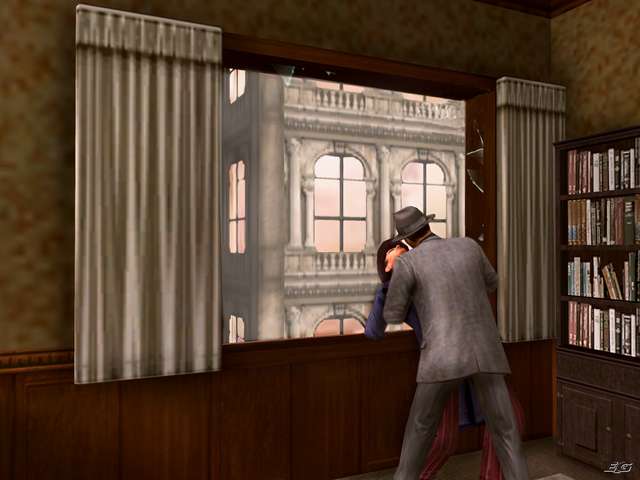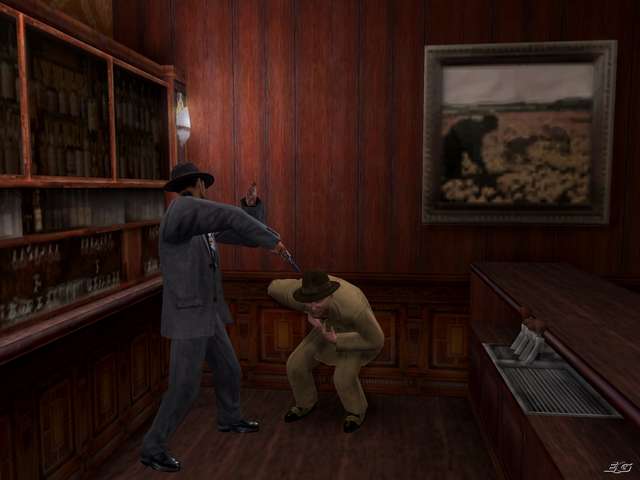The Godfather
In-depth hands-on with EA's blockbuster.
Four and a half years on from the atomic explosion of Grand Theft Auto III, the fallout's still raining down on the games business. The blast-proof Electronic Arts initially hid in its bunker, thumbing its nose at the genre, with execs routinely vocal about how it was a 'family' publisher that didn't really go around making such gratuitously violent titles. Fair enough. It's not as if it didn’t dominate enough categories to last a lifetime to have to worry about getting its hands dirty.
But the smell of money evidently lured EA out into the irradiated open air. Rockstar's trio of 10 million+ sellers since late 2001 demonstrated in the best possible fashion that these open-ended drivin'-shootin'-lootin' games are what people want, so EA got the message and found an ancient yet enduring license that more or less fits perfectly with Rockstar North's enormously flexible and influential game design template.
With the allure of 1940s New York as the hub, EA had a fantastic location right from the word go, populated with stylishly dressed folk and the kind of salubrious, curvy classic cars that look fun to drive (but probably weren't). Sprinkle in the brutal glamour of rival family turf wars, petty extortion and small-time racketeering, and immediately it seems obvious that The Godfather brand lends itself perfectly to the genre that was built upon the principles on climbing the crime ladder.
All new wise guys

Wisely, EA has chosen to avoid putting gamers in the shoes of any of the characters from the movie or the original Mario Puzo novel, therefore giving much more flexibility by avoiding having to strictly adhere to the plot. Kicking off with a short-lived flashback sequence, you enjoy a brief chance to punch out a few thugs before you get shot down by a rival family.
At that point you're given the chance to seek vengeance and create your own hood (the son of the guy who just got taken out) in a manner reminiscent of the Tiger Woods GameFace or The Sims 2 system. In typical EA style you're given an enormous range of physical features to tweak and customise, encompassing hairstyles, clothes, right down to specific facial characteristics such as eyebrow length, fullness of lips, and even how dark the circles are under your eyes. In our midnight-oil-burning case, that's quite a lot, then. Unlike many previous create-a-player attempts, you really do get a sense that you're building something potentially unique, as opposed to selecting from basic stock models, and all the way through the game the fruits of your labour become evermore apparent in cut scenes and other subtle ways.
And so onto the game itself, The Godfather wears its influences on its sleeve from the word go, unashamedly lifting practically every decent trick in the GTA repertoire, but in a style that's far removed from the modern day world of Tommy Vercetti and Carl Johnson. After the basic melee combat introduction at the beginning (where punches are fluidly delivered by the right analogue stick), your pal Luca teaches you the ropes with a few standard missions where you get to learn how to extort local businesses as well as rough up college punks, act as a getaway driver and take out assassins. All in a day's work.
Safe as houses

In familiar fashion, you've got your own safehouse which works in precisely the same way as GTA, giving you an opportunity to save your progress, top up your health and even grab a baseball bat. Main story missions and the various side missions appear on your mini map in the corner of the screen, and practically any car you see can be quickly hijacked. However, EA has gone a little further than Rockstar in terms of making it a more user friendly game, ironing out some of the most obvious annoyances that blight many GTA players' experiences. Chief of these is an in-mission checkpointing system that doesn't force players to start the whole thing from the beginning if they happen to get iced along the way, while dying during general sorties around the city won't result in the loss of all your weapons. Even better, the purchase of certain safe houses grants you access to a stash of weapons, saving those unnecessary visits to Ammunation, and allowing you to just get on with the business of playing missions and making progress.
Another definite improvement over GTA is the control system. While it feels initially similar to Rockstar's efforts, the main enhancement is a far more fluid combat system that allows players a much greater degree of reliability and flexibility than usual. The system works on two levels; the default operates on a useful auto targeting method which selects the nearest enemy when you press the left shoulder button. If they're behind cover it maintains the lock-on, allowing you to quickly pop a cap in them when they re-appear.
Sometimes, though, that basic method leaves you exposed, and you can either quickly switch to another nearby target with the right stick, or make small adjustments to your auto-aim, allowing you to pull off head shots, shoot the weapon out of their hand, or shoot their arm and render them unable to fire back.
Gangs of New York

If you're really confident, you can also switch to manual aiming by tapping the white button. This makes the camera control deliberately 'stiff' but basically makes it exceptionally easy to make minor adjustments to your aim, and therefore easy to shoot your target exactly where you want. In open cover, this isn't an especially good idea, as you'll soon discover that a few well-placed shots are enough to finish you off, but by ducking down, or hiding behind walls you can pull off precision shots without being easy cannon fodder. In fact, by far one of the most effective combat manoeuvres in the entire game is hiding behind a wall, shuffling to the edge, targeting an enemy and hitting the right trigger when they're exposed. In one swift motion you can take out a locked-on target and release the trigger to duck back to safety, and - once mastered - it's an enjoyable and slick way of taking out entire gangs of thugs.
Of course, health is a big issue during combat, and The Godfather takes the well-worn approach of offering occasional health vial pick-ups, which appear to be bottle of hard liquor. Although it's easy to die during careless encounters, there's always a chance to replenish supplies - and with the knowledge that the checkpoints offer respite, there's not quite the same sense of 'all or nothing' frustration when things go wrong, and we like that about The Godfather.
Weapons wise, expect a fairly standard selection for the majority of the game, including a baseball bat, lead pipe, Molotovs, pistol, snub nosed pistol, magnum, shotgun and Tommy gun. Later you might find that it's advisable to source the various three star upgrades to turn a previously vanilla selection into an arsenal of death, such as the Saturday Night Special, the Street Sweeper or the ultimate, the $500,000 Dillinger.



